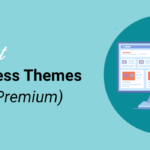Choosing the Right WordPress Theme: A Step-by-Step Selection Guide

1 November 2023
Creating a visually appealing and functional website starts with choosing the right WordPress theme. With an abundance of options available, navigating the vast sea of themes can be overwhelming. However, a strategic approach to theme selection can make this process more manageable and help you find the perfect fit for your website. This step-by-step selection guide will walk you through the essential considerations to ensure you make an informed decision.
1. Define Your Website’s Purpose and Goals:
Before delving into the vast array of themes, clearly outline the purpose and goals of your website. Is it a blog, a portfolio, an e-commerce site, or a combination of these? Understanding your website’s primary function will guide you towards themes designed for specific purposes.
2. Consider Design and Layout:
The visual appeal of your website is crucial for engaging visitors. Evaluate different themes based on their design and layout options. Consider the color schemes, typography, and overall aesthetic to ensure it aligns with your brand identity. Additionally, assess the flexibility of the theme’s layout customization to meet your specific needs.
3. Assess Responsiveness and Mobile Optimization:
In today’s digital landscape, a significant portion of web traffic comes from mobile devices. Ensure that the theme you choose is responsive, meaning it adapts seamlessly to various screen sizes. Mobile optimization is not just a convenience but a necessity for providing an excellent user experience.
4. Review Theme Features and Functionality:
Explore the features offered by each theme. Look for essential elements like customizable headers, footers, and widget areas. Check if the theme supports the plugins you plan to use and offers options for integration with essential tools. A feature-rich theme ensures scalability as your website grows.
5. Check Theme Performance:
Website speed and performance are critical factors for user satisfaction and search engine rankings. Run performance tests on the themes you are considering to ensure they are optimized for speed. Choose a theme that strikes the right balance between functionality and performance.
6. Examine Theme Documentation and Support:
A well-documented theme with comprehensive guides can save you a lot of time during the setup and customization process. Additionally, assess the level of support provided by the theme developer. A theme with active support forums and timely updates is essential for addressing any issues that may arise.
7. Evaluate Cross-Browser Compatibility:
Your website should offer a consistent experience across different web browsers. Test the theme on various browsers to ensure compatibility. A theme that works seamlessly on popular browsers like Chrome, Firefox, Safari, and Edge will enhance user accessibility.
8. Consider SEO Friendliness:
Search engine optimization (SEO) is crucial for driving organic traffic to your website. Choose a theme that is SEO-friendly, with clean code and optimization features. Some themes come with built-in SEO options, making it easier for you to optimize your content.
9. Review User Reviews and Ratings:
Before making a final decision, check user reviews and ratings for the themes you are considering. Real-world experiences from other users can provide valuable insights into the theme’s performance, ease of use, and support.
10. Test Theme Customization Options:
Finally, take advantage of any demo versions or trial periods offered by theme developers. This allows you to test the theme’s customization options and see how well it aligns with your vision for your website. Ensure that the theme is user-friendly and doesn’t require advanced coding skills for basic customization.
In conclusion, choosing the right WordPress theme involves a thoughtful and systematic approach. By considering your website’s purpose, design preferences, functionality requirements, and other essential factors, you can narrow down your options and make an informed decision that sets the foundation for a successful online presence.





